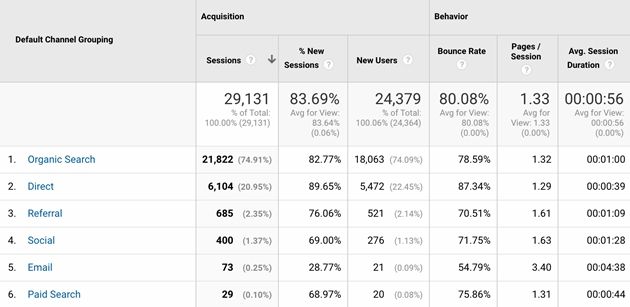Most content marketers strive to create content that not only speaks directly to their target audience but also compels that audience to take desirable actions with the marketer's business or brand.
That sounds terrific in theory, but producing such content is easier said than done; there simply isn't a template or solution that works for every business.
To create high-performing content that drives business goals, content marketers must create content highly tailored to their specific industry or niche—no matter how oversaturated or "boring" that industry may seem—and also personalized for their specific audience.
Concentrating more on your audience's needs, segmenting your community, and using content experimentation can help you to plan for the crafting of more personalized content that's best suited to meet your marketing goals—as well as inspire your customers to take actions you'd like them to take.
1. Invest in learning about your customers
Organizations that are committed to investing in their customers are up to 60% more profitable than "non-customer-centric" companies, and 67% of senior marketing executives use customer customer insight- and emotion-based data to develop the right content.
Agencies and research firms can help you get to know your audience, but they typically cannot replace the hands-on insight that you can collect internally by analyzing your own data sources and by engaging with your customers directly and organically.
To learn more about your current customers, start by consulting your Web analytics software (Google Analytics, Adobe Analytics, etc.) to get a better understanding of your online visitors.
More specifically, you should look at audience reporting metrics to learn about the demographic information, interests, and behavioral trends of your online users.

Audience/Demographics/Age Trends Report, Google Analytics
Audience reports can help you determine whether your current content and other marketing efforts are attracting the age group of your target audience—and help you identify any surprising outliers in your data.
For example, if the marketers with the above-depicted data set were aiming to reach a Millennial audience, their marketing efforts would be aligning well with their target audience; however, if they were targeting senior marketing executives, there would be a serious disconnect.
Next, look into your acquisition insights to determine where your visitors are coming from:

Acquisition/All Traffic/Channel Report, Google Analytics
For this site, a majority of traffic is coming from organic search, which could indicate that its content has been properly optimized for search engines. Since the content is performing well in search, the marketers could invest in additional keyword research to understand more about what their customers are searching for online.
In a similar situation, you may find that your site is receiving significant traffic from an unexpected source. If so, you'll need to dig deeper into the channel that's sending the traffic to identify the cause.
For a more hands-on approach to learning about your audience, begin engaging with your current customers, speak with your sales team, sit in on product-demo calls, and start conversations with your potential customers.
Consider doing the following to learn more about your audience:
- Meet with your customer success teams and ask them about your buyers.
- Send out surveys, or ask for other feedback, through email.
- Research online content to learn more about what your customers are talking about.
- Research product-review sites for public ratings or feedback.
- Monitor mentions of your brand using social listening tools or Google Alerts.
2. Segment your audience to inform your content strategy
After getting a top-level idea about your customers via both your analytics solution and hands-on engagement, you are ready to begin creating customer segments.
Customer segmentation can help you target the different types of people who are engaging with your content by informing how you should market content to them.
Start by integrating all of your customer data. For many content marketers, Google Analytics is the go-to; however, others use Adobe Analytics, Tableau, or Mixpanel for mobile solutions, among many others. Use the tools available to you.
Next, identify customer differentiators or behaviors that are important to your business goals.
The idea is that you become familiar with all of the ways that you can segment your audience using your analytics platform so that you can better understand what type of personalized content and user experiences that you should create.

Audience Segmentation, Google Analytics
For example, software companies with a subscription model should learn more details about why certain customers are retained month over month or annually, whereas other customers cancel their subscription.
Key differentiators could be...
- Age, gender, location
- Buyer personas
- Purchasing history
- Brand and social engagement
- Time on site
- Total number of pageviews
Although there are many ways you can segment your audience, start small by identifying 3-4 groups that are valuable enough to market to. This approach can help you avoid over-analyzing and increases the likelihood that you will be able to take action on the segments you create.
It's also a best-practice to create segments that are mutually exclusive, to avoid overlap in your customer data that could muddle your research and lead to miscommunication.
3. Experiment with your content to identify wins
After thoroughly researching your audience and determining which segments to target, the next step is to create new content and marketing campaigns to address your findings.
Experiment with at least five content formats, such as detailed articles, video tutorials, whitepapers, webinars, conferences, e-books, and others to better determine what content resonates with your segmented audience.
Measure the performance of your content efforts by analyzing how the data in your audience segments changes in the days, weeks, and months after executing your content. Remember that content marketing efforts can be slow to yield returns, so you should keep your short-term expectations within reason.
Also collect insight on your content distribution methods to identify how your audience wants to receive content. Think about paid advertising campaigns, promotion through social channels, influencer marketing, employee advocacy, press releases, and other ways to that you are distributing your content. Analyze how much traffic each of your marketing channels is driving and the actions on site that those visitors are performing.
Generally, you should address the needs of one segment before moving on to others, and you should start with the segment that is most valuable to your business goals.
If you don't know where to start, experiment with a few of your segment ideas until you find traction. Doing so can help you and your team work through the growing pains of marketing to new audiences without the added stress of trying to cover all segments at once.
For more advanced personalization techniques, you can use a tool like Optimizely, Visual Website Optimizer, or Unbounce to deliver custom user experiences for each of your segments and personalize content across your website, mobile app, and any other connected devices.
* * *
Have you invested in creating more personalized content? How have you learned about what your customers are interested in? Do you use customer segmentation techniques to inform your marketing efforts? Share your experiences with me in the comments section below or by sending me a tweet.




